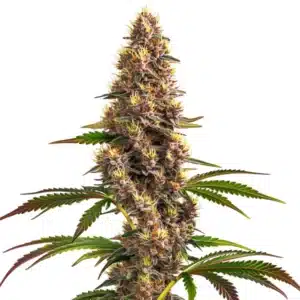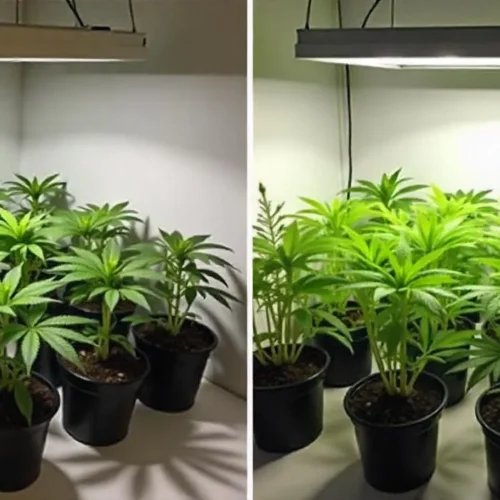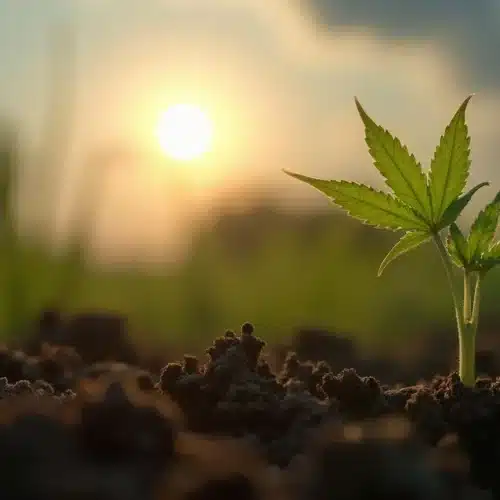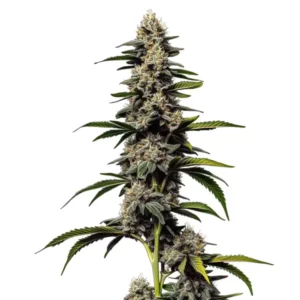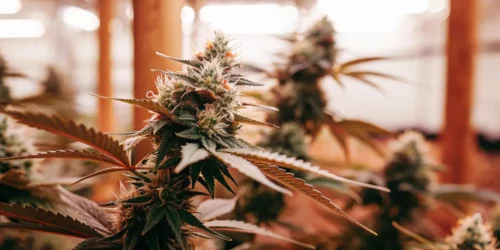Yellow spots on cannabis leaves are a common issue, and knowing the cause is essential. Do all yellow marijuana leaves share the same cause? Not at all. Various factors contribute to these spots, including specific pests like Septoria that cause yellow spots on the leaves. It might seem overwhelming, but let’s break it down step by step to determine why your plant has yellow spots.
Before finding a solution, we must first diagnose the issue correctly. We’ll explore different causes, starting with the most common and moving to the more specific. Let’s begin taking care of your marijuana plants.
Recommended Strains
Gorilla Glue #4 Fast Version
 THC: 19 - 22%
THC: 19 - 22% Type of seed: Feminized
Type of seed: Feminized Phenotype: Mostly Sativa
Phenotype: Mostly Sativa Day to flower: 6 - 8 weeks
Day to flower: 6 - 8 weeks
Gorilla Glue #4 Fast Version CBD
 THC: 5% - 14%
THC: 5% - 14% Type of seed: Fast Flowering
Type of seed: Fast Flowering Phenotype: Mostly Sativa
Phenotype: Mostly Sativa Day to flower: 8 - 10 weeks
Day to flower: 8 - 10 weeks
What is Leaf Septoria?
Leaf Septoria, also known as yellow leaf spot, is a disease that targets the foliage of cannabis, including the specific condition known as cannabis leaf septoria, as well as potatoes, tomatoes, and eggplants. The condition is caused by the fungus Septoria Lycopersicon and typically affects plants during their flowering stage. The first sign of leaf Septoria is the appearance of yellow spots on cannabis leaves.
The fungus thrives in plant debris and rapidly develops its spores in damp, warm environments, with temperatures ranging from 60–80°F. Once mature, the spores spread to crops through water and wind.
This disease initially targets the lower leaves and later spreads to the upper sections. As yellow spots on cannabis leaves progress, the infected plant weakens and fails to reach maturity. Without timely treatment, the disease hinders plant growth and destroys their foliage. This damage stresses the crops, reduces their quality, and diminishes the harvest size.
Promos & Deals
How does Septoria reproduce, causing yellow spots on cannabis leaves?
Septoria reproduces through spores produced by the Septoria spp. fungus. These spores, which are small, can be carried by wind and rain from an infected plant to another. They can also hitch a ride on insects and other organisms that feed on infected leaves. Once these Septoria spores land on a leaf, they can germinate and penetrate the plant tissue. Inside the leaf, the fungus develops and reproduces, generating more spores that spread to other parts of the plant and nearby plants. One of the most common early symptoms of infection is yellow spots on autoflower leaves, which can signal the onset of Septoria and should be addressed immediately to prevent further spread.
Septoria can survive in infected plant debris and in the soil for several years, facilitating its spread across multiple growing seasons. Spores can also be transported on agricultural equipment, as well as on clothing and shoes of people working in the fields. Therefore, it is crucial to implement preventive measures to halt the disease’s spread and minimize its impact.
Why Do Cannabis Leaves Develop Yellow Spots?
There are several reasons why yellow spots appear on cannabis leaves. One of the primary causes is a pH imbalance, which can lead to nutrient deficiencies. Overwatering is another common issue that can cause yellowing. Pests can also contribute to the yellowing of cannabis leaves.
Flowering Marijuana Plant with Yellow Spots on Leaves: Overwatering?
We continue to investigate the potential issues that can lead to yellow spots on the leaves of a flowering marijuana plant. In this instance, we focus on the possibility of overwatering, as an excess of water can result in marijuana leaves developing yellow spots. While underwatering can also be detrimental, it presents with different symptoms.
To rule out overwatering, you have two options: either use a moisture meter or rely on the traditional method. Lifting the pots regularly allows you to gauge the need for watering by the weight of the pots, providing a straightforward and effective solution.

Yellow Spots on Cannabis Leaves: Watch the Light!
It’s surprising that the subject of lighting hasn’t been discussed yet. Indeed, poor lighting could be the reason for yellow spots on cannabis leaves, and it can stem from either too much or too little light.
If yellow spots on your cannabis leaves are concentrated at the top and spreading from there, it likely means your light source is too close. Conversely, if the yellowing starts at the bottom and spreads upwards, your plant needs more light.
The solution isn’t as simple as it seems. Damaged leaves, especially burnt ones, can be tough to remove, so prevention is key. To avoid yellow spots, consider using a glass shield to protect your plant from the light.
Yellow Marijuana Leaves Due to Temperature
When discussing light, temperature also comes into play. Yellowing can be due to both light and temperature. To check, touch the leaf for about 30 seconds. If it feels hot, your plant is likely suffering too.
Heat can cause yellowing even without light issues. Keep temperatures below 26-28ºC to avoid yellowing and to maintain bud density. However, don’t let it drop below 10ºC, as this can also cause yellow spots on the leaves.
Yellow Plague on Marijuana Plants
It’s odd that pests haven’t been mentioned yet. Pests can cause leaves to change color, including yellow spots. Septoria is a specific pest that causes yellow leaves on cannabis. There are also fungi that can turn leaves brown or black, but our focus here is on yellowing due to pests like Septoria.

Does Leaf Septoria Affect All Parts of a Cannabis Plant?
Does Septoria spread to buds or other parts of the cannabis plant? This disease typically doesn’t harm marijuana flowers but can infect autoflower seeds and other variations. Leaf Septoria primarily targets the leaves.
Leaf Septoria on Cannabis: Early Signs
Before you learn how to treat sick cannabis, it’s essential to detect leaf septoria early. Here are the initial signs of the disease:
The first indication is a change in color. The infected plant’s hue shifts from green to yellow, with yellow spots appearing in various locations. Over time, the cannabis plants may turn brown and begin to wither.
What kind of climate is favorable for Septoria?
Septoria can be favored by a warm and humid climate, conditions that are prevalent in many parts of the world. The fungus spores can spread through the air and settle on plant leaves, where they germinate and penetrate leaf tissue. Infection spreads more rapidly under high humidity and mild temperatures, typically around 20-25°C, which are optimal for fungal growth.
Consequently, this disease may be more prevalent in regions with frequent rainfall and high ambient humidity. Prolonged leaf moisture provides a conducive environment for fungal growth and transmission, leading to rapid infection spread.
Conversely, dry and hot weather conditions can reduce disease incidence as low humidity limits fungal growth and spread. However, extremely dry and hot climates can stress plants, making them more susceptible to Septoria and other issues. Proper hydration of plants becomes crucial under such conditions.

Symptoms and damages caused by Septoria on cannabis leaves with yellow spots.
The symptoms of Septoria disease can vary depending on the fungus species and the type of plant infected. Generally, symptoms include the appearance of small, dark spots on the plant’s leaves, which can reach up to 1 cm in diameter. These spots typically have a circular or oval shape, often surrounded by a yellow or light brown border—closely resembling yellow dots on cannabis leaves, a common early sign of fungal infection that growers should watch for.
As the infection progresses, the spots enlarge and may merge, covering large areas of the leaf. Infected leaves may begin to turn yellow and prematurely fall off the plant, weakening it and reducing fruit or grain production.
For example, in tomato crops, Septoria can significantly decrease fruit production and quality. Infected plants may yield smaller and less flavorful fruits, and the disease can spread to other parts of the plant such as stems and branches.
In the case of wheat and other cereals, Septoria tritici, causing yellow spot disease, can lead to a significant reduction in grain yield and wheat quality. The disease may reduce grain weight and protein content, negatively impacting flour quality.

Symptoms and damages caused by Septoria on cannabis leaves with yellow spots.
Preventing Septoria disease is crucial to safeguarding crops from fungal infections. Effective cultivation practices such as crop rotation, removal of infected plant debris, and using healthy, resistant seeds are among the best ways to prevent this disease.
Additional measures to prevent Septoria include reducing plant stress through proper watering and balanced fertilization. Maintaining a clean, weed-free environment around plants is also important to minimize moisture and spore spread. Prompt action is necessary upon detecting Septoria infection. Treatment involves fungicide application and pruning infected plant parts. Fungicides are typically applied to infected leaves to eradicate fungi and prevent disease spread. Responsible fungicide use, following manufacturer guidelines, is essential to prevent fungal resistance.
Another effective control method is selecting plant varieties resistant to Septoria. By choosing resistant varieties, farmers can decrease fungicide dependency, prevent future infections, and ultimately enhance crop yield.
If a Septoria infection is detected, immediate control measures are crucial. Treating this disease may involve using fungicides and pruning infected parts of the plant. Fungicides are typically applied to infected leaves to kill fungi and prevent the disease from spreading to other parts of the plant. However, responsible fungicide use is essential, following manufacturer recommendations to avoid fungal resistance.
Another effective control method involves using plant varieties resistant to Septoria. By selecting resistant plant varieties, farmers can decrease fungicide dependency and prevent future infections, thereby enhancing overall crop yield.
FAQs
What causes yellow spots on cannabis leaves?
Yellow spots on cannabis leaves can result from various issues such as nutrient deficiencies, pH imbalance, overwatering, lighting problems, or pest infestations like Leaf Septoria. Proper diagnosis is essential to treat the underlying problem effectively.
Can Leaf Septoria be the reason for yellow spots on cannabis leaves?
Yes, Leaf Septoria is one of the primary fungal diseases responsible for yellow spots on cannabis leaves. It typically starts on lower foliage and progresses upward, weakening the plant and reducing yield if left untreated.
How can I prevent yellow spots on cannabis leaves caused by Septoria?
To prevent yellow spots on cannabis leaves due to Septoria, maintain proper humidity and temperature levels, remove plant debris, rotate crops, and use resistant strains. Early detection and applying fungicides when necessary can stop the disease from spreading.




